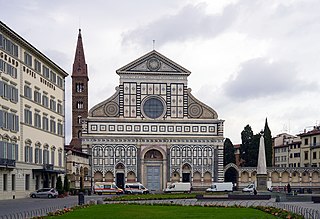
Michelangelo di Lodovico Buonarroti Simoni, known mononymously as Michelangelo, was an Italian sculptor, painter, architect, and poet of the High Renaissance. Born in the Republic of Florence, his work was inspired by models from classical antiquity and had a lasting influence on Western art. Michelangelo's creative abilities and mastery in a range of artistic arenas define him as an archetypal Renaissance man, along with his rival and elder contemporary, Leonardo da Vinci. Given the sheer volume of surviving correspondence, sketches, and reminiscences, Michelangelo is one of the best-documented artists of the 16th century. He was lauded by contemporary biographers as the most accomplished artist of his era.

Donato di Niccolò di Betto Bardi, known mononymously as Donatello, was an Italian sculptor of the Renaissance period. Born in Florence, he studied classical sculpture and used his knowledge to develop an Early Renaissance style of sculpture. He spent time in other cities, where he worked on commissions and taught others; his periods in Rome, Padua, and Siena introduced to other parts of Italy the techniques he had developed in the course of a long and productive career. His David was the first freestanding nude male sculpture since antiquity; like much of his work it was commissioned by the Medici family.

Santa Maria Novella is a church in Florence, Italy, situated opposite, and lending its name to, the city's main railway station. Chronologically, it is the first great basilica in Florence, and is the city's principal Dominican church.

Mino da Fiesole, also known as Mino di Giovanni, was an Italian Renaissance sculptor from Poppi, Tuscany. He is noted for his portrait busts.

Desiderio da Settignano, real name Desiderio de Bartolomeo di Francesco detto Ferro was an Italian Renaissance sculptor active in north Italy.

Antonio Gamberelli (1427–1479), nicknamed Antonio Rossellino for the colour of his hair, was an Italian Renaissance sculptor. His older brother, from whom he received his formal training, was the sculptor and architect Bernardo Rossellino.

Bernardo di Matteo del Borra Gamberelli (1409–1464), better known as Bernardo Rossellino, was an Italian Renaissance sculptor and architect, the elder brother of the sculptor Antonio Rossellino. As a member of the second generation of Renaissance artists, he helped to further define and popularize the revolution in artistic approach that characterized the new age. His work is often hard to distinguish from that of his brothers working in the family workshop.

The Basilica di Santa Croce is a minor basilica and the principal Franciscan church of Florence, Italy. It is situated on the Piazza di Santa Croce, about 800 metres southeast of the Duomo, on what was once marshland beyond the city walls. Being the burial place of notable Italians, including those from the Italian Renaissance such as Michelangelo, Galileo, and Machiavelli, as well as the poet Foscolo, political philosopher Gentile and the composer Rossini, it is also known as the Temple of the Italian Glories.

Lorenzo di Credi was an Italian Renaissance painter and sculptor best known for his paintings of religious subjects, and portraits. With some excursions to nearby cities, his whole life was spent in Florence. He is most famous for having worked in the studio of Andrea del Verrocchio at the same time as the young Leonardo da Vinci, who seems to have influenced his style considerably.

Settignano is a frazione on a hillside northeast of Florence, Italy. The little borgo of Settignano carries a familiar name for having produced three sculptors of the Florentine Renaissance, Desiderio da Settignano and the Gamberini brothers, better known as Bernardo Rossellino and Antonio Rossellino. The young Michelangelo lived with a sculptor and his wife in Settignano—in a farmhouse that is now the "Villa Michelangelo"— where his father owned a marble quarry. In 1511 another sculptor was born there, Bartolomeo Ammannati. The marble quarries of Settignano produced this series of sculptors.

Benedetto da Maiano was an Italian Early Renaissance sculptor.

Giovanni Antonio Boltraffio was an Italian painter of the High Renaissance from Lombardy, who worked in the studio of Leonardo da Vinci. Boltraffio and Bernardino Luini are the strongest artistic personalities to emerge from Leonardo's studio. According to Giorgio Vasari, he was of an aristocratic family and was born in Milan.

Matteo di Giovanni was an Italian Renaissance artist from the Sienese School.
The decade of the 1420s in art involved some significant events.
The decade of the 1430s in art involved some significant events.

Benedetto Buglioni (1459/1460–1521) was an important Italian Renaissance sculptor specialised in glazed terracotta.

Santa Maria Assunta is a Roman Catholic parish church located in Settignano, a frazione of Florence in the region of Tuscany, Italy.

Stiacciato (Tuscan) or schiacciato is a technique where a sculptor creates a very shallow relief sculpture with carving only millimetres deep. The rilievo stiacciato is primarily associated with Donatello (1386–1466).

Francesco Nori was a Florentine banker. During the Pazzi assassination attempt of 1478 he protected Lorenzo de' Medici, saving his life at the cost of his own.

The following catalog of works by the Florentine sculptor Donatello is based on the monographs by H. W. Janson (1957), Ronald Lightbown (1980), and John Pope-Hennessy (1996), as well as the catalogs of the 2022/2023 exhibitions in Florence, Berlin and London. In the case of unsigned or documented works, the attributions and dates are, as is usual, based predominantly on stylistic criteria and analogies to secured works. Many of the works attributed to Donatello were created in collaboration with other artists and with specialists in specific techniques.



















